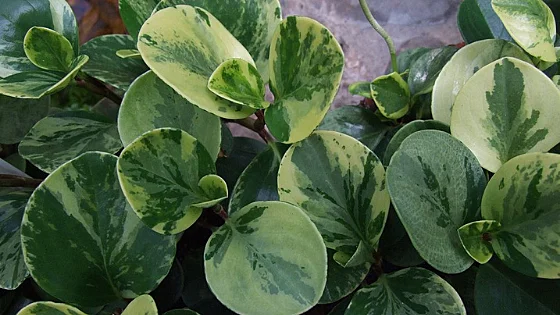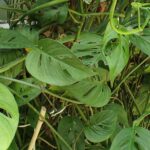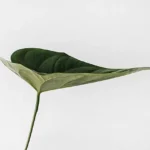Peperomia Obtusifolia is a gorgeous little plant which is ideal for indoor pots, hanging baskets or understory ground cover.
A super hardy specimen, Peperomia Obtusifolia is also known as the Baby Rubber Plant and is a wonderful choice for peperomia enthusiasts, especially those just starting out.
Table of Contents
Profile
Peperomia Obtusifolia has deep green, fleshy leaves that are roundish in shape. It’s has a lovely trailing habit which lends itself particularly well to hanging baskets, where its foliage can spill over the sides.
Obtusifolia develops slender flower spikes of up to 12 centimetres (around 5 inches) in length. The flowers are a pale green in colour, and lend a wonderfully unconventional air to this cute plant.
Native to South America, Peperomia Obtusifolia is a tropical beauty and despite its common name, is not related to the rubber plant and, therefore, will not provide you with the raw materials for elastic bands.
Character
Peperomia Obtusifolia has an extremely hardy nature and will flourish for even those totally lacking a green thumb!
How To Care For Peperomia Obtusifolia
Water
So the number one rule for most houseplants is DO NOT OVERWATER! And this goes double or triple for Peperomia Obtusifolia.
Hardy, yes, but those gorgeous little fleshy leaves are super water storage vessels, just like the hump of a camel, and you don’t want to overfill them, because they will wilt and rot and you’ll have done the unthinkable – killed the unkillable.
So, how do you water them?
First, don’t be scared to let them dry right out. You can check for moisture by sticking your finger into the top inch or so of soil. If it’s dry – you can water.
Make sure that when you do water, you really wet Obtusifolia right through and let all the excess water drain out. This is a far better method than giving it little sips of water, as it better mimics little Obtusifolia’s natural habitat.
If you are still unsure of when to water, don’t worry, Obtusifolia’s leaves will thin and grow wrinkly when they really need a drink. Water thoroughly and they will perk right back up within a few hours.
Like most plants, Peperomia Obtusifolia prefers rain or filtered water, but if you don’t have access to either of these, you can fill bottles with water and leave them in the sun for 24 hours to purify.
Soil
Peperomia Obtusifolia hates soggy or wet feet, so it follows that the soil needs to be light, airy and well draining.
Choose a mix with something coarse in it like orchard bark or coco coir, and make sure there’s also some well composted organic matter in there too – you need something rich in the mix for little Obtusifolia to feed on.
Fertilizer
Peperomia Obtusifolia has a very shallow root system and if you have the soil mix right, they shouldn’t require much in the way of fertilization. If you have to fertilize, do it once a year in spring (the growing season) with a well balanced liquid feed.
Light
In its natural habitat, Peperomia Obtusifolia is an understory plant in the rainforest. As such, it enjoys dappled shade or bright, indirect sunlight. Plant Obtusifolia in dark, shady spots in your garden and watch it thrive.
Indoors, place Obtusifolia in bright light, but never direct sunlight.
Peperomia Obtusifolia will also survive under fluorescent lights, making it an awesome choice for your desk at the office.
Temperature
Peperomia are frost sensitive, so keep them indoors if you are in colder areas. They won’t like big changes in temperature either, so don’t place them near cooling or heating vents.
They do like humidity, so if you don’t live in the tropics and don’t want to turn up the heat inside, you might consider creating a microclimate around your peperomia.
You can do this by clustering like minded plants, and placing a dish of water near them (the idea is that this will create extra water vapour around your plants).
Alternatively, you could fill a spray bottle with rainwater and mist your Peperomia when the fancy takes you. If you do feel like splashing out, you could consider the purchase of a humidifier to place amount your more exotic houseplants.
Propagation
Peperomia Obtusifolia truly has to be one of the most simple plants around to propagate and one Obtusifolia can quickly become many plants! The easiest ways to propagate are through stem or leaf cuttings, and these can be placed in soil or water.
For stem cuttings in soil:
- Select a longish stem of around 7 – 8 centimetres, or around 3 inches.
- Snip your stem just below a node (nodes are the joins’ in the stem of a plant, and this is where new growth will form), ensuring you have at least three leaves on your chosen stem.
- Pop the cutting into soil. Obtusifolia stems are floppy, so you can either pop in a little stake (wooden chopsticks are perfect for this) and tie your cutting upright to the stake, or you can plant your cutting at an angle and lay the rest of the cutting on the surface of the soil.
- Keep the soil moist, but never wet.
- Wait for roots to develop after around two weeks.
For leaf cuttings in soil:
- Select a large, healthy leaf.
- Snip it where the stem of the leaf joins the main stem.
- Make a horizontal hole in your soil.
- Pop the leaf in around halfway, so half the leaf is under the soil the other half is over the soil.
- Little baby plants will appear at the base of the leaf. This can take some time (sometimes months), so be patient!
For stem cuttings in water, it’s basically the same as for soil. You just pop your cutting in a bit of water, ensuring that the leaves are not submerged. Roots and baby plants will appear under the water in a matter of weeks.
Transplant to soil when the roots are around 5cm (2 inches) long, leaving the baby plants and their mother above the soil. This is fiddly work and a toothpick is a great help.
Pruning
Pinching’ is an excellent method for pruning and keeping your Obtusifolia nice and compact.
Pests and Diseases
Peperomia Obtusifolia is extremely resistant to pests and is far more likely to die from a hovering plant parent who overwaters!
Jerzy Opioła, CC BY-SA 4.0, via Wikimedia Commons


